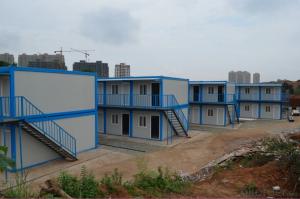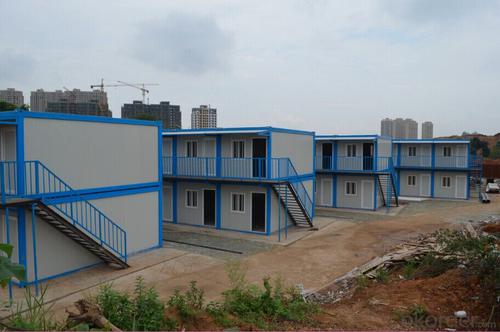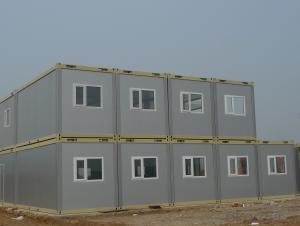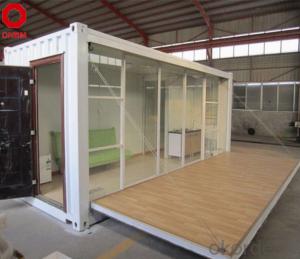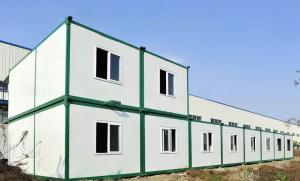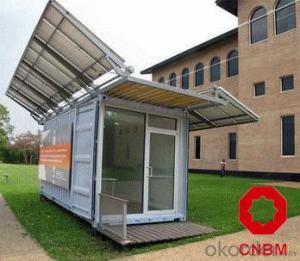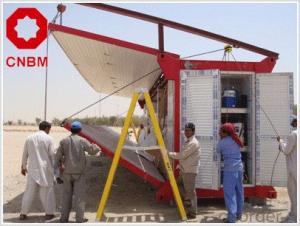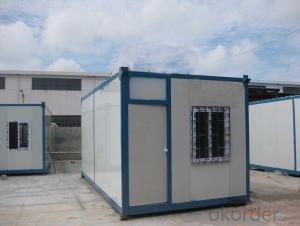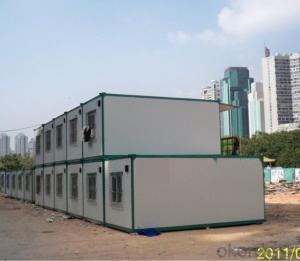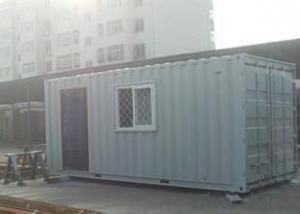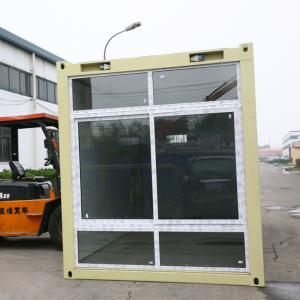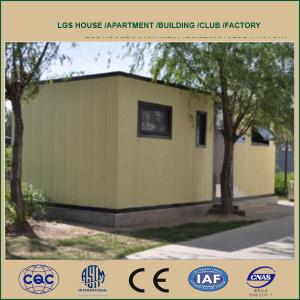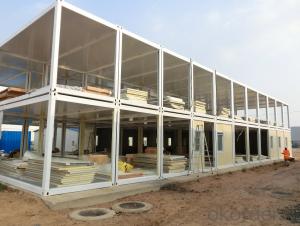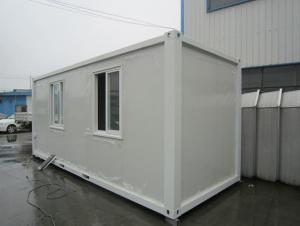Chinese Portable and Mobile Container Houses
- Loading Port:
- Tianjin
- Payment Terms:
- TT OR LC
- Min Order Qty:
- 1 pc
- Supply Capability:
- 10000 pc/month
OKorder Service Pledge
OKorder Financial Service
You Might Also Like
Chinese Portable and Mobile Container Houses
Product introduction
The assembled series slope roof prefabricated houses
"Constant" brand series of slope roof assembled prefabricated houses is the company launched a new concept of environmental protection building economical activities, ordinary, standard and luxury type 3 kinds.According to customer demand, in a standard module for space combination, formed the skeleton system USES light steel structure, and to sandwich panels and PU tile forming palisade and roofing system.Realize the simple and beautiful, the construction fast, use safety, the standard of general overlay idea, make the overlay houses into an industrialized production, inventory, for repeated use of stereotypes housing products.
Sex can
Reliable structure: light steel system of flexible structure, safe and reliable, satisfies the requirement of building structure design codes.
Tear open outfit is convenient: housing can be repeatedly disassembling, repeated use.The installation process need only simple tools.Average per person per day to install 20-30 square meters, 6 people a team, 2 days to complete 3 k standard prefabricated houses 1 x 10 k.
Beautiful decoration: housing overall beautiful, bright color, texture soft, board face level off, have good adornment effect.
Flexible layout: doors and Windows can be installed in any position, interior partition can be set in any horizontal axis.The stairs set outside.
The structure of the building structure waterproof, waterproof design, does not need to do any other waterproof processing.
Long service life, light steel structure anticorrosion coating processing, normal service life can reach more than 10 years.
Environmental conservation: the reasonable design, easy tear open outfit, can be used many times cycle, low attrition rate, do not produce construction waste, the average annual cost is much lower than other materials of similar houses.
Using standardized components, a variety of specifications: building length and width are to K (1 K = 1820 mm) for the module.Transverse dimensions of mk + 160, the longitudinal size of nk + 160.
With the way
Are widely used in road, railway, construction and other field operation of temporary housing construction;Urban municipal, commercial and other temporary housing, such as: temporary office, conference room, headquarters, dormitory and temporary stores, temporary schools, temporary hospitals, temporary parking area, temporary exhibition hall, temporary filling stations, etc.
Assemble series flat roof prefabricated houses
"Constant" assembled series flat roof prefabricated housing is through making full use of their own strength of sandwich wall panel and roof panel, after pulling, bolts, self-tapping screw connection and finalize the design activities of housing system.Can be industrialized production, use, interior decoration, realize the inside and outside is beautiful, fast, safe construction overlay concept, tight sealing, heat insulation, waterproof, fireproof, moistureproof.
Aesthetically pleasing: housing overall modelling beautiful, inside and outside are color decorative plates, good appearance, design and colour collocation to coordinate.
Long use period: normal service life can reach more than 10 years.Convenient transportation, dismantling recycling, environmental savings.
With the way
Are widely used in road, railway, construction and other field operation of temporary housing construction;Urban municipal, commercial and other temporary housing.Such as: temporary office, conference room, headquarters, dormitory and temporary stores, temporary schools, temporary hospitals, temporary parking area, temporary exhibition hall, temporary maintenance, temporary transformer room, temporary filling stations, etc.Other temporary housing areas, such as military logistics temporary occupancy, rescue and relief temporary occupancy, sterile laboratories, isolation rooms, communication substation room.Scenic area of temporary use leisure villa, vacation homes, etc.
Products > > activity control box, the bathroom
Box is by utilizing sandwich wall panel and roof panel connection of their own strength, by screw, bolts, self-tapping screw, wall sandwich plate and the steel structure base housing system composed of roof plate connection.Quick construction, whole movable, especially suitable for municipal facilities and field construction site of the gatehouse, service, etc.
Toilet is mainly is made of light steel structure, caigang sandwich board maintenance material, to give expulsion-typely wastewater and circulating water storage (microbes) drainage way portable toilet.Can be very convenient to install, move, move, especially suitable for streets, sports venues, the use of tourist attractions.
Fence is made of steel structure column, double color sandwich steel or single color pressed steel by bolt connection and into.All of its components are composed of standard parts, the arbitrary assembly, short installation period, the effect is good, the color can be specially made according to the requirements.Repeatable tear open outfit, use, construction waste, beautiful appearance.
- Q: Can container houses be designed with solar power systems?
- Yes, container houses can definitely be designed with solar power systems. In fact, container houses are an excellent candidate for utilizing solar power due to their modular and compact nature. Solar panels can be easily installed on the roof of a container house, taking advantage of the ample sunlight exposure. These panels capture sunlight and convert it into electricity, which can then be used to power various appliances and systems within the house. Container houses are often designed with energy efficiency in mind, and incorporating solar power systems aligns perfectly with this goal. By harnessing solar energy, container houses can reduce their reliance on traditional energy sources, ultimately leading to lower energy costs and a smaller carbon footprint. Moreover, container houses can also be equipped with energy storage systems, such as batteries, to store excess electricity generated by the solar panels. This allows for a continuous supply of electricity even during periods of low sunlight or at night, making container houses self-sufficient and independent from the grid. In summary, container houses can be efficiently designed with solar power systems, providing a sustainable and eco-friendly solution for energy needs. With the advancements in solar technology and the increasing focus on renewable energy, incorporating solar power in container house design is a logical and beneficial choice.
- Q: What are the design options for container houses?
- The design options for container houses are diverse and versatile. They can range from a simple, minimalist layout to a more complex and spacious design. Some popular design options include open floor plans, multiple levels, and creative use of windows and doors for natural light. Additionally, container houses can be customized with various exterior finishes, such as cladding, paint, or even green roofs, allowing for a wide range of aesthetic possibilities.
- Q: Can container houses be used as vacation homes?
- Yes, container houses can definitely be used as vacation homes. In fact, they are becoming increasingly popular for this purpose due to their affordability, sustainability, and versatility. Container houses are essentially repurposed shipping containers that are transformed into fully functional living spaces. They can be customized and designed to suit individual preferences and needs, making them ideal for vacation homes. One of the main advantages of container houses as vacation homes is their cost-effectiveness. Building a traditional vacation home can be quite expensive, whereas container houses offer a more affordable alternative. The materials used for container houses are readily available, and the construction process is relatively quick and straightforward, resulting in significant cost savings. Additionally, container houses are eco-friendly and sustainable. By repurposing shipping containers, we're reducing waste and recycling materials that would otherwise go unused. This makes them an attractive option for environmentally conscious vacationers. Furthermore, container houses can easily incorporate sustainable features such as solar panels, rainwater harvesting systems, and energy-efficient appliances, further reducing their environmental impact. Container houses are also highly versatile when it comes to design and functionality. They can be modified and customized to include all the necessary amenities and comforts required for a vacation home. From bedrooms and bathrooms to kitchens and living spaces, container houses can be tailored to suit the needs of vacationers. They can even be expanded or combined to create larger living spaces or accommodate more guests. Moreover, container houses are portable and can be transported to different locations, making them ideal for vacation homes. Whether you want to have a vacation home by the beach, in the mountains, or any other desired location, container houses can be easily moved and set up wherever you choose. This flexibility allows vacationers to enjoy different destinations and experiences without the need for multiple properties. In conclusion, container houses can absolutely be used as vacation homes. They offer a cost-effective, sustainable, and versatile housing solution that can be customized to fit individual preferences and needs. With their portability and adaptability, container houses provide an excellent option for those seeking a unique and eco-friendly vacation experience.
- Q: Are container houses suitable for disaster relief efforts?
- Yes, container houses are suitable for disaster relief efforts. They are cost-effective, easily transportable, and can be quickly set up in affected areas. These houses provide temporary shelter for displaced individuals, offering a safe and stable living environment during recovery and rebuilding processes.
- Q: How do container houses compare to traditional houses in terms of resale value?
- Container houses typically have a lower resale value in comparison to traditional houses, primarily because they differ from traditional homes in a few aspects. Firstly, container houses are often viewed as unconventional and less mainstream, which can limit their appeal to a broader range of potential buyers. Moreover, container houses generally have limited square footage and may lack certain amenities and features commonly found in traditional homes. Additionally, the construction materials used in container houses, such as steel and corrugated metal, may not possess the same level of aesthetic appeal or durability as the materials employed in traditional houses. This can negatively affect the overall perceived value of the property. Nevertheless, it is worth noting that the resale value of a container house can also be influenced by various factors like its location, design, and customization. If the container house is situated in a desirable location, designed with meticulous attention to detail, and incorporates high-quality finishes, it may attract a niche market of buyers who appreciate the unique charm of container living, potentially increasing its resale value. Ultimately, although container houses generally do not possess the same resale value as traditional houses, there are circumstances in which they can retain their value or even appreciate.
- Q: Can container houses be designed to have a green or living wall?
- Certainly, it is possible to incorporate green or living walls into container houses. These walls, also known as vertical gardens, consist of plants grown vertically on specialized structures using hydroponics or soil-based methods. Container houses offer a unique opportunity for implementing green walls due to their modular and stackable nature. By installing a supporting structure, such as a trellis or wire mesh, the walls of a container house can easily be transformed into vertical gardens. There are many advantages to having green walls in container houses. Firstly, they add natural beauty to the industrial look of the containers, enhancing the overall aesthetics of the structure. Additionally, green walls improve insulation and energy efficiency by acting as a natural barrier that reduces heat gain in the summer and heat loss in the winter, reducing the need for excessive heating or cooling. Moreover, green walls contribute to environmental sustainability. They absorb carbon dioxide and release oxygen, improving air quality and reducing the carbon footprint of the house. Furthermore, they act as sound barriers, reducing noise pollution from the surroundings. When designing a container house with a green or living wall, it is important to consider factors such as proper irrigation, drainage, and plant selection. The irrigation system should be designed to provide adequate water without causing damage to the container. Drainage systems should be in place to prevent water accumulation and structural issues. Additionally, selecting the right plants is crucial for the success of the green wall. Vertical growth and the ability to thrive in the specific conditions of the container house, such as limited sunlight or exposure to wind, should be considered when choosing plants. In conclusion, container houses can be designed to incorporate green or living walls. These walls not only enhance the aesthetics but also provide environmental benefits such as improved insulation, air quality, and noise reduction. With careful planning and design, container houses can have sustainable and eco-friendly living spaces.
- Q: Can container houses be easily transported overseas?
- Container houses have the advantage of being easily transported overseas due to their mobility and ease of transportation. The shipping containers used to build these houses are specifically designed to be transported by ships, trucks, and trains, making them suitable for international shipping. They can be loaded onto cargo ships and transported across oceans to reach different countries. The durability of container houses is due to their construction using steel, which allows them to withstand the rigors of transportation. They are built to endure heavy loads and extreme weather conditions encountered during shipping. Additionally, their standardized dimensions make them easy to stack and secure on cargo ships, ensuring their safe transport. Furthermore, container houses can be disassembled and reassembled relatively easily, facilitating their transportation overseas. They can be loaded onto trucks or trailers and transported to ports for shipping. Once they arrive at the desired destination, they can be easily reassembled into habitable structures. However, several factors need to be considered when transporting container houses overseas. These include obtaining the necessary permits and approvals, complying with local regulations, and ensuring proper transportation logistics and infrastructure at the destination port. Additionally, the cost of transportation, including shipping fees and customs duties, should be taken into account when assessing the feasibility of transporting container houses overseas. In conclusion, container houses are designed to be easily transported overseas, and with proper planning and logistics, they can be successfully delivered and reassembled in different countries.
- Q: Can container houses be designed to have a guest room?
- Container houses have the potential to incorporate a guest room into their design. These houses are highly customizable and can be transformed into comfortable living spaces that include all necessary amenities, including guest rooms. It is possible to expand the layout of the container house by connecting multiple containers or adding additional modules in order to accommodate specific requirements, such as a dedicated guest room. The interior of the container can be creatively designed to create a cozy and inviting space for guests, complete with a comfortable bed, storage options, and even a small seating area. To ensure sufficient natural light and ventilation in the guest room, windows, skylights, and proper insulation can be incorporated. In conclusion, container houses offer great flexibility in terms of design, making it feasible to include a guest room as part of the overall layout.
- Q: Can container houses be designed to have a backyard?
- Yes, container houses can be designed to have a backyard. Container houses are highly versatile and can be customized to meet the specific needs and preferences of the homeowner. While the initial structure is made from shipping containers, they can be modified and expanded upon to create additional living spaces, including a backyard. Designing a backyard in a container house can be achieved through various methods. One option is to utilize the roof of the container as a patio or outdoor living area. By adding a sturdy, weather-resistant flooring and appropriate furniture, the roof can be transformed into a functional backyard space. This allows homeowners to enjoy outdoor activities, entertain guests, or simply relax in the comfort of their container house. Another option is to extend the container house itself to create a dedicated backyard space. This can be achieved by adding additional containers or constructing additional rooms adjacent to the main structure. By expanding the living space, homeowners can have a backyard area that is directly accessible from the main living area, providing convenience and ease of use. Furthermore, container houses can also incorporate traditional backyard elements such as gardens, lawns, or even swimming pools. By carefully planning the layout and using creative landscaping techniques, container houses can have beautifully designed backyards that offer a peaceful and enjoyable outdoor experience. In conclusion, container houses can be designed to have a backyard. Through innovative design and customization, homeowners can create a backyard space that suits their needs and preferences, allowing them to fully enjoy the benefits of living in a container house while also having access to a functional and inviting outdoor area.
- Q: Can container houses be designed to have a high-end, luxurious interior?
- Yes, container houses can definitely be designed to have a high-end, luxurious interior. With the right design and materials, container houses can be transformed into elegant and stylish living spaces. Incorporating high-quality finishes, modern fixtures, and luxurious furnishings can create a sophisticated and upscale ambiance within a container house. Additionally, customizations such as spacious floor plans, designer kitchens, luxurious bathrooms, and high-end technology can further enhance the overall luxurious feel of the interior.
Send your message to us
Chinese Portable and Mobile Container Houses
- Loading Port:
- Tianjin
- Payment Terms:
- TT OR LC
- Min Order Qty:
- 1 pc
- Supply Capability:
- 10000 pc/month
OKorder Service Pledge
OKorder Financial Service
Similar products
Hot products
Hot Searches
Related keywords
